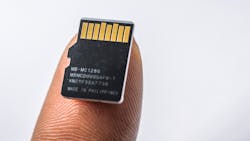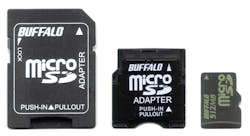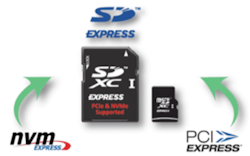What are the Differences Between MicroSD and MicroSD Express?
What you’ll learn
- Types of high-performance SD cards.
- Differentiating speeds between microSD and microSD Express.
- Applications that use these types of cards.
MicroSD and microSD Express are both types of flash-memory cards that are used to store data in electronic devices, such as smartphones and cameras. The main difference between the two is their transfer speeds. microSD (Secure Digital) cards have a slower transfer speed, while microSD Express cards are much faster. MicroSD Express cards also use the PCI Express (PCIe) or NVM Express (NVMe) interface, which is faster than the standard SD interface used by microSD cards.
The microSD format, first introduced by SanDisk in 2005, was initially known as T-Flash, then TransFlash before being named microSD when it started to be used by the SD Card Association (SDA). The first microSD card had a 128-MB capacity and was about the size of a fingernail. Since then, the capacity of microSD cards has dramatically increased, and it’s now possible to purchase cards with capacities of up to 1 TB.
The small form factor and high storage capacity of microSD cards have made them popular for use in mobile devices. They’re now extensively used in smartphones, tablets, and other portable devices. MicroSD cards also have been widely adopted in embedded systems, IoT, and other connected devices.
The microSD card was initially slow to gain traction, as mobile devices at the time had limited storage capacity and used embedded memory. However, as mobile devices and digital cameras became more popular, the demand for removable memory increased, and the microSD card became the go-to memory card for many consumers.
The card has gone through several iterations over that time, increasing its capacity to 2 TB in 2020. While it's widely used in mobile devices, it's also employed in many industrial and medical applications, such as sensors, GPS systems, and medical imaging.
MicroSD Formats and Features
Every device, from a camera to a drone, has different SD card requirements. For example, a drone may require a microSD card with a high-speed class rating to write data very fast. However, if the card has a lower rating that can't write fast enough, it may not be compatible with the drone. With that in mind, microSD cards are available in various formats and storage capacities (Fig. 1), including:
- SD (Secure Digital): The original format, with a capacity of up to 2 GB.
- SDHC (Secure Digital High Capacity): An updated format with a capacity of 4 to 32 GB.
- SDXC (Secure Digital Extended Capacity): A further updated format with a capacity of 64 GB to 2 TB.
- SDUC (Secure Digital Ultra Capacity): The latest format, with a capacity of 2 to 128 TB.
Furthermore, microSD cards may have different features, such as:
- Speed class: Indicates the minimum write speed of the card, with classes ranging from 2 to 10. The higher the class, the faster the card can write data.
- UHS (ultra-high speed): Indicates the card's maximum read and write speeds, with classes ranging from 1 to 3.
- A1 or A2: Indicates the card's performance level for running apps on a device. A1 cards are recommended for most apps, while A2 cards are better suited for high-performance apps.
- Video Speed Class: Indicates the minimum write speed of the card for recording and playback of video, with classes ranging from V6 to V90.
MicroSD card speeds are measured in terms of read and write speeds, which are typically expressed in megabytes per second (MB/s) or kilobytes per second (KB/s). The maximum read speed of a card is usually faster than its maximum write speed. Some common speed classifications for microSD cards include:
- Class 2: Minimum write speed of 2 MB/s
- Class 4: Minimum write speed of 4 MB/s
- Class 6: Minimum write speed of 6 MB/s
- Class 10: Minimum write speed of 10 MB/s
- UHS-I: Minimum write speed of 10 MB/s, maximum read speed of 104 MB/s
- UHS-II: Minimum write speed of 30 MB/s, maximum read speed of 312 MB/s
- UHS-III: Minimum write speed of 60 MB/s, maximum read speed of 624 MB/s
In addition to speed classifications, microSD cards can have different power requirements. Some cards require a higher voltage to operate, while others may have lower power requirements. A card's power requirements will be specified by the manufacturer and should be considered when choosing a card for a particular device. Certain devices may be unable to supply the necessary power to run certain cards.
It’s also worth noting that a high-speed card doesn't mean it will perform well in all situations. The device that the card is being used in must support the high speed, too.
MicroSD Express Formats and Features
MicroSD Express (Fig. 2) is a new generation of microSD cards that uses the NVMe protocol to achieve faster read and write speeds. First announced by the SD Association in June 2018, the technology is based on the PCIe and NVMe standards. The first microSD Express cards were released in 2019 by various manufacturers such as Lexar, Samsung, and Sandisk.
These cards typically have read speeds of around 985 MB/s and write speeds of around 950 MB/s, making them much faster than traditional microSD cards and their maximum read speed of around 100 MB/s. As with microSD, microSD Express comes in several formats and storage capacities. MicroSD Express cards are available in the standard microSD form factor and are backward compatible with devices that support previous generations of microSD cards. Their capacities range from 128 GB to 1 TB.
In terms of features, microSD Express cards offer faster read and write speeds than traditional microSD cards, as they use the NVMe protocol. They also support the A2 (Application Performance Class 2) and Video Speed Class 90 standards, ensuring higher performance levels for apps and video recording. They’re also built with advanced error correction and wear-leveling features to ensure data integrity and prolong the card's life.
Furthermore, some microSD Express cards have built-in encryption features, such as AES 256-bit, allowing users to protect their data with a password. This feature can be useful for storing sensitive information on the microSD card.
Overall, microSD Express cards are designed for devices requiring high-speed data transfer, e.g., smartphones, action cameras, drones, and other portable devices. They’re also useful for storing large amounts of data, such as photos, videos, and music, and for running apps and games that require high performance.
As mentioned earlier, microSD Express cards come in various storage capacities, ranging from 128 GB to 1 TB. The storage capacity of a microSD Express card determines how much data can be stored on it. For example, a 128-GB card is able to store approximately 26,000 photos, eight hours of 4K video, or 130,000 songs, while a 1-TB card can store approximately 200,000 photos, 64 hours of 4K video, or 1 million songs.
Regarding power requirements, microSD Express cards are designed to be low power and don’t require additional power for their operation. They’re targeted at applications that typically have built-in power sources (smartphones, tablets, cameras).
Some devices that use microSD Express cards may have specific power requirements. For example, a device that supports 4K video recording may require a higher power input to operate at the maximum recording quality. In general, users should check the specifications of their device to ensure that it’s compatible with the MicroSD Express card they’re considering and meets the device's power requirements.
Conclusion
The differences between microSD and microSD Express can be boiled down to several key features, with the main being increased speeds and storage capacities. PCIe and NVMe protocols make the latter much faster with higher data throughput. The same can be said for storage capacities, as microSD evolved over time to gain 1-TB capacities, while that same storage parameter hit microSD Express much faster. So, what does the future hold for both technologies?
Continued improvements are expected for both, especially when it comes to their storage capacities. We will likely see these cards with capacities reaching 2 TB or more. This will enable users to store even larger amounts of data, such as full-length movies, entire music libraries, and extensive collections of photos and videos.
Another anticipated advance is the speed of both card types. As technology evolves, these cards may have even faster read and write speeds. As a result, devices will be able to transfer data more quickly, improving the performance of applications and allowing for smoother playback of high-definition video and audio. There’s also a chance to see the integration of newer technologies, such as 5G and Wi-Fi 6, in microSD and microSD Express cards, bringing greater data-transfer speeds and enhanced connectivity capabilities.
On top of that, as the demand for data storage ramps up, the use of these cards may expand to new types of devices and applications, further increasing their utility and popularity. Overall, the future of microSD and microSD Express looks promising, with continued advances in storage capacities, speed, and other features that will make them even more useful and versatile.
About the Author
Cabe Atwell
Technology Editor, Electronic Design
Cabe is a Technology Editor for Electronic Design.
Engineer, Machinist, Maker, Writer. A graduate Electrical Engineer actively plying his expertise in the industry and at his company, Gunhead. When not designing/building, he creates a steady torrent of projects and content in the media world. Many of his projects and articles are online at element14 & SolidSmack, industry-focused work at EETimes & EDN, and offbeat articles at Make Magazine. Currently, you can find him hosting webinars and contributing to Electronic Design and Machine Design.
Cabe is an electrical engineer, design consultant and author with 25 years’ experience. His most recent book is “Essential 555 IC: Design, Configure, and Create Clever Circuits”
Cabe writes the Engineering on Friday blog on Electronic Design.



